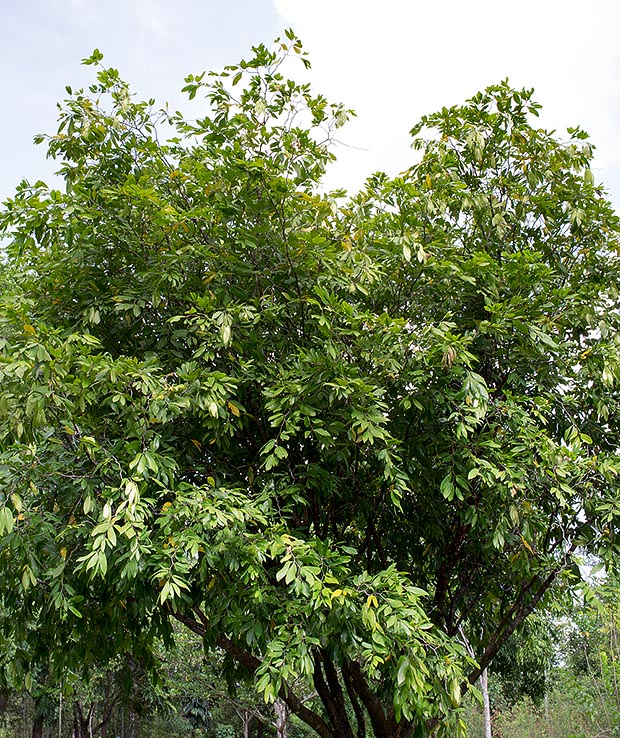Family : Fabaceae

Text © Pietro Puccio

English translation by Mario Beltramini

Native to South-East Asia, Cynometra cauliforla is a very ramified small tree not exceeding the 8 m © G. Mazza
The exact origin place is not known, it is mainly diffused in India, Indonesia (Java and Kalimantan), Peninsular Malaysia, Sulawesi and Sumatra.
The name of the genus comes from the combination of the Greek substantives “κύων, κυνός” (cyon, cynós) = dog and “μήτρα” (metra) = uterus, with reference to the shape of the fruits; the specific name is the combination of the Latin substantives “caulis, is” = caul and “flos, oris” = flower with reference to the flowers that grow directly on the trunk.
Common names: nam nam, niam niam, puki (India); nam nam, namu namu (Indonesia); katak puru, salah nama (Peninsular Malaysia); hima, nang-ai (Thailand).
The Cynometra cauliflora L. (1753) is a shrub or a small evergreen tree very ramified, that usually does not exceed the 8 m of height, with brown-greyish bark. The leaves, on a 0,4-0,8 cm long petiole, are alternate, formed by two oblong-ovate leaflets, asymmetric with respect to the central rib, with obtuse or slightly pointed apex and entire margins, 6-15 cm long and 2-5 cm broad, of glossy dark green colour above, pale green below, coriaceous; the young leaves, of bright pink colour, drooping, are particularly ornamental. The inflorescences are short compact racemes grouped at the nodes of the trunk or of the main branches, often close to the ground, with small bisexual flowers, of about 0,8 cm of diameter, with calyx usually quadripartite with white-pinkish lobes, about 0,4 cm long and broad, retroflexed, 5 thin white or white-pinkish lanceolate petals, about 0,4 cm long, 8-10 stamina and about 0,5 cm long style. The fruits are reniform legumes with yellowish pulp, edible, 5-10 cm long, 4-5 cm broad and 1,2-3 cm thick, with wrinkly surface of brown green colour turning greenish yellow when ripe, containing one seed only, 3,5-6 cm long.
It usually reproduces by seed, previously kept in water for two days, in organic loam with addition of coarse siliceous sand or agri-perlite per a 30% maintained humid at the temperature of 26-28 °C, with rather long germination times, 1-3 months and first fructification starting from the 6th-7th year.
Slow growing species present mainly in South-East Asia where is often cultivated in the family gardens for its fruits, needs a tropical of humid subtropical climate, not bearing temperatures close to the 0 °C, with high annual rainfall, full sun or partial shade and rich soils, slightly acidic to neutral.

The inflorescences are short compact racemes grouped on the nodes of the trunk with small bisexual flowers of about 0,8 cm. The ediile fruits, containing one seed only, are 5-10 cm long reniform legumes with yellowish pulp. The ripe fruits are slightly sourish, the unripe ones are to be eaten only cooked. Medicinal properties © G. Mazza
The unripe fruits have a particularly sour taste and are consumed only cooked, the ripe ones have a pleasant taste, slightly acidulous and are consumed fresh, added in salads or typical dishes for aromatizing them, fried in batter or cooked with sugar for jams. Various parts of the plant are employed in the traditional medicine for several pathologies, the oil extracted from the seeds in the skin diseases and in the leprosy. Laboratory studies have evidenced in the extracts of the fruits antileukemic properties and in all parts of the plant of compounds having antioxidant propertiess of potential interest for the official pharmacopoeia.
Synonyms: Cynometra cauliflora var. elongatis Hassk (1842); Cynometra cauliflora var. subsessilis Hassk. (1842); Cynometra acutifolia S.Vidal (1886).
→ To appreciate the biodiversity within the family of FABACEAE please click here.
